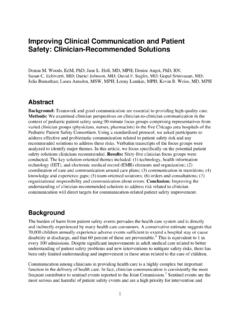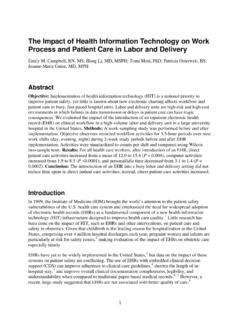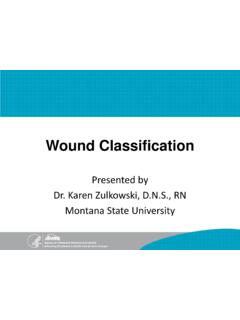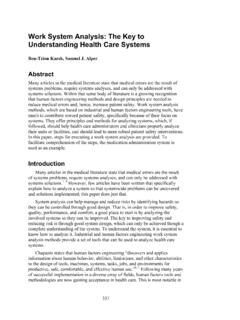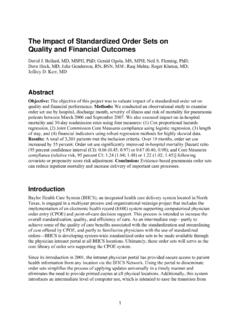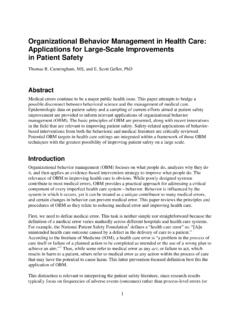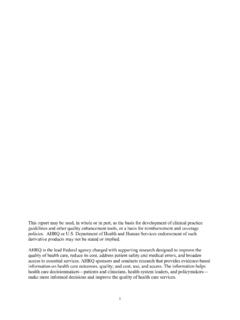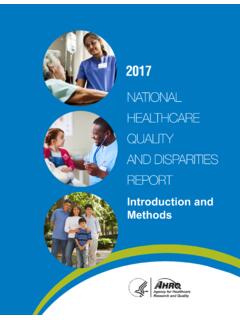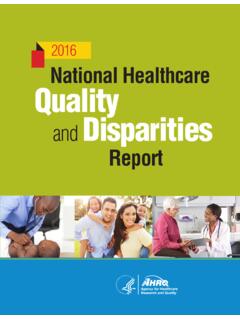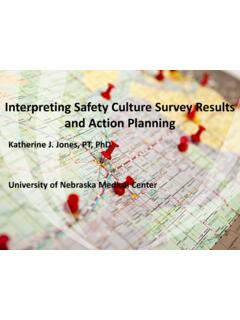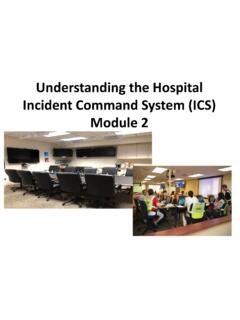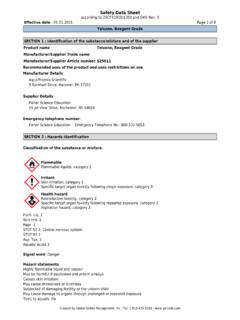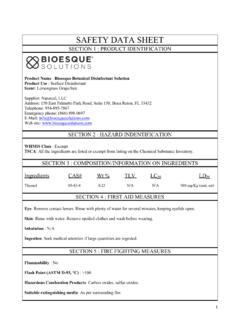Transcription of Selected Best Practices and Suggestions for Improvement
1 Toolkit for Using the AHRQ Quality IndicatorsHow To Improve Hospital Quality and Safety 1 Tool Selected Best Practices and Suggestions for Improvement IQI: Mortality Review of Select Procedures and Conditions Why Focus on Mortality Review? The 1999 Institute of Medicine report To Err is Human: Building a Safer Health System focused the attention of the health care community and the public on the estimation that between 48,000 and 98,000 deaths from medical errors occur each year. Sixty percent of the sentinel events reported to the Joint Commission between 2004 and June 2013 resulted in a patient The National Quality Forum states: Healthcare organizations must systematically identify and mitigate patient safety risks and hazards with an integrated approach in order to continuously drive down preventable patient harm.
2 2 Structured, multidisciplinary review is required to identify system processes that may result in failures in care, adverse events, and mortality. Understanding of system processes is necessary to take proactive steps to reduce preventable deaths. Starting in 2014, a number of mortality rates that are relevant to the IQIs will be used for Medicare s Hospital Value-Based Purchasing (as part of a composite indicator) that links quality to payment: o Acute Myocardial Infarction 30-Day Mortality Rate [similar to IQI 15 Acute Myocardial Infarction (AMI) Mortality Rate and IQI 32 Acute Myocardial Infarction (AMI) Mortality Rate, Without Transfer Cases] o Heart Failure 30-Day Mortality Rate [similar to IQI 16 Heart Failure Mortality Rate] o Pneumonia 30-Day Mortality Rate [similar to IQI 20 Pneumonia Mortality Rate] o Acute Ischemic Stroke 30-Day Mortality Rate [similar to IQI 17 Acute Stroke Mortality Rate] The above mortality indicators are also reported on Medicare s Hospital Compare as part of the Hospital Inpatient Quality Reporting Program (except for Acute Ischemic Stroke 30-Day Mortality Rate, which began in July 2014).
3 Recommended Practice Details of Recommended Practice Create a process for identifying cases 100% mortality case review is recommended. Work with decision support staff or appropriate department to identify the IQIs using AHRQ software. (See Tool for additional detail.) Conduct preliminary case review Quality-trained clinicians perform initial case review to eliminate cases not needing further review and prepare Selected cases for committee presentation and identify potential causative factors Present case to mortality review committee Case is presented to committee if appropriate. Toolkit for Using the AHRQ Quality Indicators How To Improve Hospital Quality and Safety 2 Tool Conduct systematic review of case Committee systematically reviews case to determine if any followup actions are required.
4 Engage in action planning Action planning may take two forms: Counselling of staff Performance Improvement project to address systemic issues Evaluate effectiveness of actions Regularly assess actions taken to ensure that processes are being followed and the desired outcomes are achieved. IQIs for Review: This guideline will focus on an overview of a mortality review process that can be used to review the select procedures and conditions identified by AHRQ as reflecting the quality of care, as well as other mortality cases determined to require review: Select procedures: IQI 08 Esophageal Resection Mortality Rate IQI 09 Pancreatic Resection Mortality Rate IQI 11 Abdominal Aortic Aneurysm (AAA) Repair Mortality Rate IQI 12 Coronary Artery Bypass Graft (CABG) Mortality Rate IQI 13 Craniotomy Mortality Rate IQI 14 Hip Replacement Mortality Rate IQI 30 Percutaneous Coronary Intervention (PCI) Mortality Rate IQI 31 Carotid Endarterectomy Mortality Rate Select conditions.
5 IQI 15 Acute Myocardial Infarction (AMI) Mortality Rate IQI 16 Heart Failure Mortality Rate IQI 17 Acute Stroke Mortality Rate IQI 18 Gastrointestinal Hemorrhage Mortality Rate IQI 19 Hip Fracture Mortality Rate IQI 20 Pneumonia Mortality Rate IQI 32 Acute Myocardial Infarction (AMI) Mortality Rate, Without Transfer Cases Best Processes/Systems of Care Recommended Practice: Create a Process for Identifying Cases Decision support staff can identify IQI cases and all should be reviewed. Case numbers may be small so it may be beneficial to aggregate review results quarterly or biannually as appropriate to determine if there are trends in causative factors. Recommended Practice: Conduct Preliminary Case Review Quality-trained clinicians perform initial case review to screen for cases not needing further review and prepare Selected cases for committee presentation.
6 Toolkit for Using the AHRQ Quality Indicators How To Improve Hospital Quality and Safety 3 Tool The following algorithm should be used: o Demographic information Medical record number Patient name Age Gender Discharge status Date of admission Date of expiration Admission status Admission source Principal diagnosis Principal procedure Attending Service Reviewer o Case review o Was the case sent to the medical examiner? o Was an autopsy performed? o Was the case an expected death? Yes: What was the condition on admission? Hospice Do not resuscitate on admission Stage 4 cancer End stage AIDS End stage chronic obstructive pulmonary disease End stage congestive heart failure End stage dementia End stage liver disease Other _____ o Was the case not an expected death on admission but expected at the time of death?
7 Yes: Did any of the following occur during hospitalization? Death within 48 hours of admission or surgery Held in emergency department longer than 6 hours Toolkit for Using the AHRQ Quality Indicators How To Improve Hospital Quality and Safety 4 Tool Return to ICU within 48 hours of transfer out of ICU Transfer from unit to ICU within 24 hours of admission Hospitalization that is a readmission within 30 days Return to emergency department within 3 days of discharge Death associated with drug reaction Death associated with adverse drug reaction Death associated with medication error Death associated with medical device Healthcare-associated infection Fall during hospitalization Procedural complication during hospitalization Restraints used Return to surgery Change in procedure Rapid
8 Response team activation Cardiac arrest Intubation/reintubation DNR activated during hospitalization Diagnostic studies for emboli or DVT PP > 100 or INR > 6 o Was the case an unexpected death? Yes: Did any of the following occur during the hospitalization (check all that apply) Death within 48 hours of admission or surgery Held in emergency department greater than 6 hours Return to ICU within 48 hours of transfer out of ICU Transfer from unit to ICU within 24 hours of admission Hospitalization that is a readmission within 30 days Return to emergency department within 3 days of discharge Death associated with drug reaction Death associated with adverse drug event Death related to medical device Healthcare-associated infection Fall during hospitalization Procedural complication during hospitalization Restraints used Return to surgery Change in procedure Rapid response team activation Cardiac arrest Toolkit for Using the AHRQ Quality Indicators How To Improve Hospital Quality and Safety 5 Tool
9 Intubation/reintubation DNR activated during hospitalization Diagnostic studies for emboli or DVT PP > 100 or INR > 6 o Is further review required? Yes Why? o Review questions: Causes for concern: Diagnosis Documentation/communication Infection Medication Palliative care Procedures Prophylaxis Resuscitation Supervision/management Triage/transitions Human error Other_____ Recommended Practice: Present Case to Mortality Review Committee Case should be presented and pertinent details from the preliminary case review shared. Facts should presented without opinion. The committee should be multidisciplinary and at a minimum include hospital leadership, physicians and other providers, nursing staff, quality staff, and other patient care providers as indicated.
10 The committee is commited to the confidentiality of the proceedings to enable honest discussion. Recommended Practice: Conduct Systematic Review of Case Hold an open discussion with mortality review committee. o The discussion is conducted in a nonjudgmental and nonpunitive manner with input sought from all attendees regardless of hierarchy. 3 o The ability to conduct objective, comprehensive, and holistic death reviews that involve all disciplines cannot be productive unless a blame-free culture is present. 4o The incorporation of non-punitive reporting mechanisms also helps to identify areas in which change is needed and further encourages open dialogue. 5 Toolkit for Using the AHRQ Quality Indicators How To Improve Hospital Quality and Safety 6 Tool o Discussion is focused on causative factors and preventability3: Causative factors.

